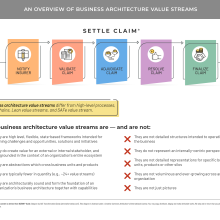In business architecture, value streams and capabilities are the ultimate power couple. Capabilities get a lot of attention, and they are indeed the connector to everything else, but they do not exist on their own. Value streams and capabilities together form the foundation of an organization’s business architecture.
This installment of StraightTalk will explore the other side of the power couple, value streams, which are sometimes a bit misunderstood. We’ll demystify what a business architecture value stream is and is not, and break it all down StraightTalk-style.
What is a business architecture value stream?
Officially defined by the BIZBOK® Guide, a value stream is a “visual depiction of how an organization achieves value for a given stakeholder or stakeholders within the context of a given set of business activities.”
Okay, so what does that mean and how do we use business architecture value streams?
Think about a business architecture value stream as a high-level business framework, abstracted across business units and products. It does show the business in motion, but the flow can be dynamic (i.e., not strictly left to right) as an object(s) moves through a value stream and changes state. Each value stream has a handful of stages, which are cross-mapped to the capabilities which enable them. A capability can be reused many times within and across value streams.
Here are a couple examples of value streams:
- Acquire Product – A value stream for Acquire Product would be triggered by a Customer (external stakeholder) with the intent of finding, purchasing and receiving a product which is ready to use.
- Onboard Human Resource – A value stream for Onboard Human Resource would be triggered by a Hiring Manager (internal stakeholder) with the intent of finding, hiring and onboarding a new employee or contractor who is ready to work.
The purpose of a business architecture value stream is not to represent the details of a business or operationalize it, but rather to provide business context to frame challenges, opportunities, decisions, solutions and initiatives.
(P.S. You can find many uses for value streams within other StraightTalks.)
How many value streams does an organization typically have?
An organization typically has around 24+ value streams. The number of value streams tends to increase based on the complexity of an organization’s business model (not necessarily the size of the organization).
How do we scope a value stream?
Remember that an organization’s business architecture represents the entire organization and the ecosystem in which it operates, so that applies to value streams too. Value streams are not internally-focused, but rather must create value in the eyes of the triggering stakeholder (whether internal or external). The name of the value stream should generally describe the final value being achieved.
For example, an organization would have an Onboard Human Resource value stream scoped as described earlier, not a life cycle ranging from “hire to retire,” since this would imply that the purpose of hiring a human resource was to retire them. On the other hand, an organization would have an Acquire Product value stream, scoped as described earlier, not an abbreviated “quote to cash” perspective since having made a payment but not yet having received the desired product is not value in the customer’s eyes.
The best way to scope a value stream is to first book-end it by defining the triggering stakeholder(s) and the value proposition, and then flow out the stages.
How do we model business architecture value streams?
Business architecture value streams are simple yet elegant and intentional structures. They are created based on a rigorous set of principles defined in the BIZBOK® Guide and are architecturally-sound constructs in a business architecture. In other words, they are not just one-time pictures or a set of randomly-selected boxes (even if it might seem like it at first).
Each business architecture value stream has a triggering stakeholder(s) who receives the value proposition at the end of the value stream. A value stream is comprised of stages, which have participating stakeholders, entrance criteria and exit criteria, and produce a value item. (P.S. Check out Post No. 70 for more on stakeholders.)
As you may have guessed, value streams are closely based on the business objects (a.k.a. information concepts) defined within the business architecture. For example, wherever possible business objects are used within the value stream names, the stage names, the value items and it is even the objects themselves create the movement in a value stream as they change state. (P.S. More here in Post No. 52 on how business objects are the glue for a business architecture.)
Business architecture value streams do not require a specific modeling notation (e.g., they do not use Business Process Modeling Notation).
Is a business architecture value stream the same as a value chain?
Though the two terms are often used synonymously, no. Value Streams ≠ Value Chains.
Value chains are defined and represented in different ways (e.g., the Porter value chain, as a framework for processes, as a generic way to represent an organization on-a-page), but the Porter value chain in particular can be a useful view for strategic decision-making.
What about a Lean value stream?
Nope, not the same as a business architecture value stream. Lean and business architecture value streams differ in form, function and intent. However, Lean value streams can be cross-mapped to business architecture value streams (and other business architecture domains).
What about a SAFe value stream?
Nope, not the same either. Business architecture value streams are the closest to operational value streams in SAFe. (More here in this white paper.)
What about a customer journey?
Nope. Customer journeys and business architecture value streams also differ in form, function and intent. However, they work together in complete harmony to join up a focus on customer empathy and experience design with the ability to translate customer needs into action with business architecture.
A high-level process?
Nope, not the same either. High-level processes are typically not based on an industry-wide defined set of principles as business architecture value streams are. However, they could use the same set of BIZBOK® Guide principles that value streams do – or value streams could be used as a construct for an organization’s processes. (More on that here in this white paper.)
So, how do we create business architecture value streams?
- Step 1: Bring together a cross-functional group of business subject matter experts – These should be the same people you worked with for your capability map – in fact you can define value streams and capabilities together during the same set of work sessions.
- Step 2: Define your value stream candidates – Create a list of potential value streams for your organization. This will help you get your arms around them before flowing any of them out. Leverage the BIZBOK® Guide reference models for ideas.
- Step 3: Prioritize value streams for definition – Select the top value streams to flow out now. Business architecture teams often start with 3-5 (customer- and/or partner-triggered) to begin with and then go back and define additional batches later.
- Step 4: Define each priority value stream* – For each priority value stream, first define the bookends (triggering stakeholder(s) and value proposition), then flow out the stages, participating stakeholders and value items as well as entrance and exit criteria.
- Step 5: Review priority value streams – With your business subject matter experts, review each value stream and test them by running a variety of business scenarios through them. Adjust as needed.
- Step 6: Publish and govern value streams** – Make the value streams available to the organization (or currently applicable audience) and govern any changes to them over time.
- Step 7: Repeat for the next set of value streams – Reconvene your business subject matter experts and define additional value streams as the business need arises.
* BTW, why not try some business origami when you’re creating value streams in small groups (or within other business architecture usage scenarios)? It will bring the experience alive and deepen understanding, collaboration and the formation of a common mental model. Here’s a partial example for the Settle Claim value stream which represents all the elements origami-style, with a breakout for the Claim Validation capability to highlight its related business units, processes, system applications and policy.
Enjoy!
P.S. Shout out to Fran Mether, Human-Centred Design expert from Evolve & Amplify, for the brilliant inspiration of applying business origami to business architecture.
** As soon as your value streams are approved and stable, you can begin value stream/capability cross-mapping.
And, here’s a handy summary to compare and contrast the key points.
One of the most important things you can do with business architecture is to help people shift their mindsets to think value-first and customer-first, and to consider the context of the broader ecosystem. Business architecture value streams are a powerful tool to keep that perspective front and center.
And give that business architecture origami a try and share your discoveries.
MORE GOOD STUFF
Business Origami (Service Design Network on Medium): A bit on the concept of business origami, within the context of service design, but entirely relevant to business architecture as well.
Sections 2.4 of the BIZBOK® Guide (Business Architecture Guild®): The full story on value streams straight from the source: the BIZBOK® Guide. (Business Architecture Guild® membership required.)
20 Minute Value Stream Mapping (BA Guild webinar): A Guild webinar on value stream mapping. It’s a classic. (Business Architecture Guild® membership required.)
Business Architecture Reference Models (BIZBOK® Guide): You can view business architecture reference model content including value streams maps in Part 8 of the BIZBOK® Guide (Business Architecture Guild® membership required). Downloadable content is also available in the by the Business Architecture Guild®store for both members and non-members (at a cost).
The Genius of the London Tube Map (TED Talk): A fascinating TED Talk by Michael Bierut on the accidental success of one of the most famous maps in the world. Make sure to listen to the three design principles at the end: they apply to business architecture maps too.


